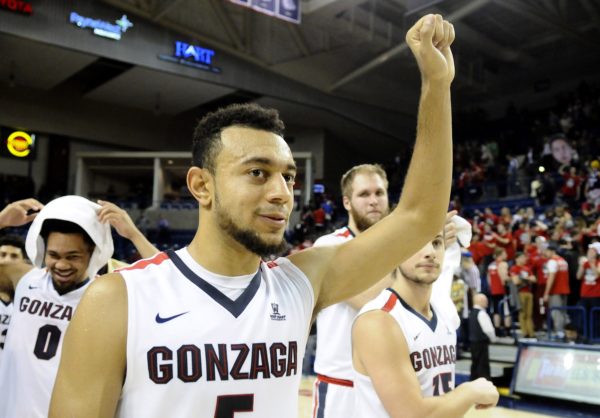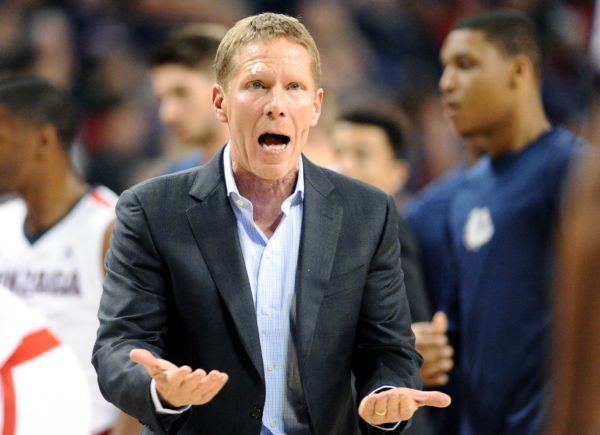Gonzaga’s New Big Men Corps Turning Supposed Weakness Into a Strength
Posted by Luke Byrnes on November 16th, 2016After a run to the Sweet Sixteen in last year’s 2016 NCAA Tournament, Gonzaga experienced significant roster turnover with Domantas Sabonis, Kyle Wiltjer, Eric McClellan and Kyle Dranginis all graduating and/or leaving for the NBA. The arrivals of transfers Nigel Williams-Goss (Washington), Jordan Matthews (California) and Jonathan Williams (Missouri), along with a freshman class that includes Zach Collins, Killian Tillie, and the return of Przemek Karnowski after a medical redshirt, give the Zags several new pieces to integrate this season. Considering the influx of backcourt talent, Gonzaga’s long-running history of stellar guard play combined with the losses of forwards Sabonis (lottery pick) and Wiltjer (rookie free agent) to the NBA, most analysts predicted Mark Few would return to a guard-oriented offense. And with good reason.
Williams-Goss, a redshirt junior, was a consensus top-50 recruit in 2013 before playing two seasons at Washington, where, as a sophomore, he led the Huskies in scoring (15.6 PPG) and assists (5.9 APG). Matthews, a graduate transfer, averaged 13.5 points per game and shot 42.7 percent from three-point range in his last two seasons at Cal. Furthermore, the Bulldogs also returned guards Kyle Perkins and Silas Melson. Perkins started all 36 games last season, led the team in assists (4.1 APG) and averaged 10.1 points per game, while Melson saw action in every game and emerged as a key contributor by averaging more than 10 PPG over the final 10 regular season games.
Following Monday night’s 69-48 win over San Diego State, Few said, “We’ve always been an inside-out program, so that’s not going to change,” a sentiment that has been echoed by longtime assistant coach Tommy Lloyd over the last several years. Whether the coaching staff will admit it or not, the Zags have consistently relied some of the best guard play on the West Coast. Even before their remarkable run of 18 consecutive NCAA Tournament appearances began — the sixth-longest streak ever and fourth-longest active stretch of its sort — Gonzaga produced excellent guards, including a guy named John Stockton.
While the Zags have also certainly had their fair share of outstanding big men, last year was just the second season since 1985 that it didn’t have a guard on the all-WCC team — although Eric McClellan was named the conference’s Defensive Player of the Year. In 2005-06, forward Adam Morrison was named the WCC Player of the Year, and big men like Kelly Olynyk, Elias Harris, Sam Dower, Wiltjer, Sabonis and Karnowski have given the Bulldogs dominant front lines of late. Olynyk and Sabonis were lottery picks and Dower and Harris are playing professionally overseas. Just two games into the 2016-17 season, it is Gonzaga’s frontcourt that appears to be the backbone of this year’s team rather than the question mark that many expected.
Karnowski is a skilled seven-footer who garnered all-WCC honors in each of his first three seasons at Gonzaga, including a first team nod as a junior in 2014-15. Williams, a 6’9″ forward who averaged nearly 12 points and seven rebounds per game as a sophomore at Missouri, gives the Bulldogs additional proven talent on the front line. But the freshman duo of 6’10” Tillie and 7’0″ Collins give Gonzaga some much-needed depth. Karnowski and Williams found themselves in foul trouble on Monday night, making way for Tillie and Collins to combine for 23 points, 18 rebounds, three blocked shots and six steals in their place. Gonzaga’s 2-3 zone, with the freshmen featuring their length and athleticism underneath, also held San Diego State scoreless for more than four minutes in the first half as the Zags turned a four-point deficit into an early six-point lead.
“Killian Tillie has been coming in and just gives us great energy. Instinctually, he is so good at flying around and finding the ball,” Few said. “We bring those two young bigs in and, a lot of the time, they’ve been growing the lead.” Karnowski added: “They’re both great for us. The motor he [Tillie] plays with is just amazing and gives energy to everyone around him.”
At this point, Tillie and Collins are like chips and salsa: not ready to be the entree but a classic appetizer. Watching them play, in person, reminded me of (don’t leave me, now, give this a chance) Wiltjer and Sabonis. Tillie – similar to Sabonis – plays like a madman. A long, lean Energizer Bunny. Raw, yes, but also a freakishly athletic terror on the defensive end – particularly in that 2-3 zone – with a soft shooting touch (he’s 3 for 5 from 3-point range this season). Collins certainly can’t shoot it from the outside like Wiltjer did, but Few will be able to run the offense through Collins with efficiency. He’s calm and patient with the ball, solid on the block with the ability to face and shoot, too. Collins has a fire inside him but, like Wiltjer, it isn’t constantly white-hot like it is in Tillie and was in Sabonis.
The ability to interchange those two with Karnowski and Williams will allow Gonzaga to continue to play inside-out and not skip a beat when, like Monday night, P.K. and/or Williams find themselves in foul trouble – things that weren’t foregone conclusions a short time ago.
Considering all the experienced talent Gonzaga has on its roster this season, the surprising depth already being provided by its young big men lends credence to the high expectations for this squad. In a year when it appeared that the strength of the Zags was reverting to backcourt play, Few’s corps of frontcourt talent isn’t quite ready to give up the mantle.











































